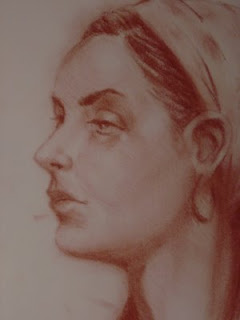
Chalk Pastel on 9x12" Strathmore paper. This one was a repro of Lipking's. The ear looks awkward that obviously I don't know what I was doing. The forehead looks short, not proportional to her bigger face inspite of the foreshortening. The sternomastoid muscle in not correctly stressed. Here is the premise: even for a small degree of error from the original the artwork would look awkward, simply because the foundation of the anatomy is weak. The structure of every part is not convincingly articulated. The artist is enslaved by his/her ignorance or lack of mastery. Some really good illustrators, like Jason Seiler, can be exageratedly or grotesquely bent, but could still maintain the facial character of the model. It's not enough if one could anatomically name all the parts (that's the easy part), but still COULD NOT draw without looking at the model. Until one has embedded visually in mind, from bones to muscles, with its contractions and extensions, and can draw them well even without a model in different perspectives and movements, then, in my opinion, the artist has mastered his craft. I thought I still have a long long way to go [sigh].